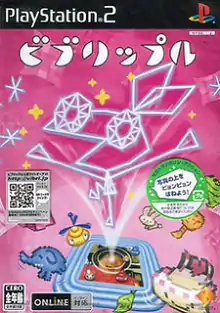Vib-Ripple
Vib-Ripple (ビブリップル, Biburippuru) is a video game for the PlayStation 2 created by Masaya Matsuura and his studio NanaOn-Sha. It is the sequel to the 1999 PlayStation game Vib-Ribbon. It was released in Japan in 2004.
| Vib-Ripple | |
|---|---|
 | |
| Developer(s) | NanaOn-Sha |
| Publisher(s) | Sony Computer Entertainment |
| Designer(s) | Masaya Matsuura |
| Platform(s) | PlayStation 2 |
| Release |
|
| Genre(s) | Action |
| Mode(s) | Single-player |
Vib-Ripple is notable for allowing the player to import photographs to be used as the game's playing field.
Gameplay
The player takes control of Vibri, the simple, vector-shaped rabbit from the game's predecessor Vib-Ribbon. The game puts the player on top of various photographs, using each one as a trampoline. Jumping on a photograph loosens up 2D items called "Peta Characters," which Vibri must collect before a time limit expires. An icon on the left side of the screen gives the player a hint as to what part of the photograph to jump on to find the item; the icon's color, shape, and size corresponds to a certain combination of the three on the photograph.[1] When Vibri is close enough to the item, a drumming sound is made and the controller vibrates. Vibri must also avoid creatures called "Boonchies" that inhabit the surface of the picture. Coming in contact with a Boonchie will cause Vibri to de-evolve from a rabbit, to a frog, to a worm, and eventually cause a game over. However, it is possible for Vibri to evolve into a form called "Super Vibri," allowing the player to temporarily disable a Boonchie, as well as see hidden Peta Characters.[1]
Vib-Ripple has 60 default photographs. The player can create their own stages by uploading their own photographs from a digital camera or cellphone via the PlayStation 2's USB port, or even send pictures across the system's online network. The game automatically scales photographs down to 200 by 200 pixels.[1]
References
- Gantayat, Anoop (May 28, 2004). "Vib Ripple Playtest". IGN.com. Retrieved 2008-11-09.